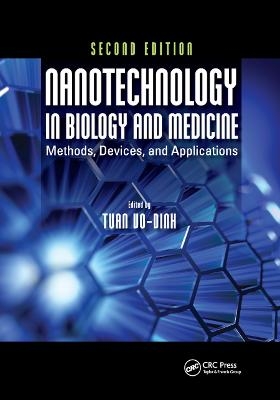
Nanotechnology in Biology and Medicine
CRC Press (Verlag)
978-0-367-86690-7 (ISBN)
The second edition of Nanotechnology in Biology and Medicine is intended to serve as an authoritative reference source for a broad audience involved in the research, teaching, learning, and practice of nanotechnology in life sciences. This technology, which is on the scale of molecules, has enabled the development of devices smaller and more efficient than anything currently available. To understand complex biological nanosystems at the cellular level, we urgently need to develop a next-generation nanotechnology tool kit. It is believed that the new advances in genetic engineering, genomics, proteomics, medicine, and biotechnology will depend on our mastering of nanotechnology in the coming decades. The integration of nanotechnology, material sciences, molecular biology, and medicine opens the possibility of detecting and manipulating atoms and molecules using nanodevices, which have the potential for a wide variety of biological research topics and medical uses at the cellular level. This book presents the most recent scientific and technological advances of nanotechnology for use in biology and medicine. Each chapter provides introductory material with an overview of the topic of interest; a description of methods, protocols, instrumentation, and applications; and a collection of published data with an extensive list of references for further details. The goal of this book is to provide a comprehensive overview of the most recent advances in instrumentation, methods, and applications in areas of nanobiotechnology, integrating interdisciplinary research and development of interest to scientists, engineers, manufacturers, teachers, and students.
Tuan Vo-Dinh is R. Eugene and Susie E. Goodson Distinguished Professor of Biomedical Engineering, Professor of Chemistry, and Director of the Fitzpatrick Institute for Photonics at Duke University. A native of Vietnam and a naturalized U.S. citizen, Dr. Vo-Dinh completed high school education in Saigon (now Ho Chi minh City). He continued his studies in Europe where he received a B.S. in physics in 1970 from EPFL (Ecole Polytechnique Federal de Lausanne) in Lausanne, Switzerland, and a Ph.D. in physical chemistry in 1975 from ETH (Swiss Federal Institute of Technology) in Zurich, Switzerland. Before joining Duke University in 2006, Dr. Vo-Dinh was Director of the Center for Advanced Biomedical Photonics, Group Leader of Advanced Biomedical Science and Technology Group, and a Corporate Fellow, one of the highest honors for distinguished scientists at Oak Ridge National Laboratory (ORNL). His research has focused on the development of advanced technologies for the protection of the environment and the improvement of human health. His research activities involve nano-biophotonics, nanosensors, laser spectroscopy, molecular imaging, medical diagnostics, cancer detection, chemical sensors, biosensors, and biochips. Dr. Vo-Dinh has authored over 400 publications in peer-reviewed scientific journals. He is the author of a textbook on spectroscopy and editor of 6 books. He holds over 37 U.S. and international patents, five of which have been licensed to private companies for commercial development. Dr. Vo-Dinh has presented over 200 invited lectures at international meetings in universities and research institutions. He has chaired over 20 international conferences in his field of research and served on various national and international scientific committees. He also serves the scientific community through his participation in a wide range of governmental and industrial boards and advisory committees. Dr. Vo-Dinh has received se
Nanotechnology at the New Frontier of Biology and Medicine. Self-Assembled Organic Nanotubes: Novel Bionanomaterials for Orthopaedics and Tissue Engineering. Gold Nanoparticles with Organic Linkers for Applications in Biomedicine. Nucleoprotein-Based Nanodevices in Drug Design and Delivery. Bimetallic Nanoparticles: Synthesis and Characterization. Nanotube-based Membrane Systems. Nanoimaging of Biomolecules Using Near-Field Scanning Optical Microscopy. Development and Modeling of a Novel Self-Assembly Process for Polymer and Polymeric Composite Nanoparticles. Cellular Interfacing with Arrays of Vertically Aligned Carbon Nanofibers and Nanofiber-Templated Materials. Single-Molecule Detection Techniques for Monitoring Cellular Activity at the Nanoscale Level. Optical Nanobiosensors and Nanoprobes. Surface Enhanced Fluorescence Based Biosensors. Biomolecule Sensing Using Surface Plasmon Resonance. Molecular SERS Nanoprobes for Medical Diagnostics. Silicon Nanoparticles for Biophotonics. Nanoscale Optical Sensors Based on Surface Plasmon Resonance (SPR). Synthetic Biology: From Gene Circuits to Novel Biological Tools. Recent Trends in Nanomaterials Integration into Simple Biosensing Platforms. Nanobiosensors: Carbon Nanotubes in Bioelectrochemistry. Monitoring Apoptosis and Anticancer Drug Activity in Single Cells Using Nanosensors. Biosensing and Theranostics Applications of Gold Nanostars. A Fractal Analysis of Binding And Dissociation Kinetics of Glucose and Related Analytes on Biosensor Surfaces at the Nanoscale Level. Integrated Cantilever Based Biosensors for the Detection of Chemical and Biological Entities. Design and Biological Applications of Nanostructured Poly(ethylene glycol) Films. Development of Gold Nanostars for Two-Photon Photoluminescence Imaging and Photothermal Therapy. Surface Plasmon Enhanced Nanohole Arrays for Biosensing. Sensitive DNA Detection and SNP Identification Using Ultrabright SERS Nanorattles and Magnetic Beads for In Vitro Diagnost
| Erscheinungsdatum | 23.12.2019 |
|---|---|
| Verlagsort | London |
| Sprache | englisch |
| Maße | 178 x 254 mm |
| Gewicht | 453 g |
| Themenwelt | Medizin / Pharmazie ► Physiotherapie / Ergotherapie ► Orthopädie |
| Medizin / Pharmazie ► Studium ► 1. Studienabschnitt (Vorklinik) | |
| Technik ► Medizintechnik | |
| Technik ► Umwelttechnik / Biotechnologie | |
| ISBN-10 | 0-367-86690-0 / 0367866900 |
| ISBN-13 | 978-0-367-86690-7 / 9780367866907 |
| Zustand | Neuware |
| Haben Sie eine Frage zum Produkt? |
aus dem Bereich


